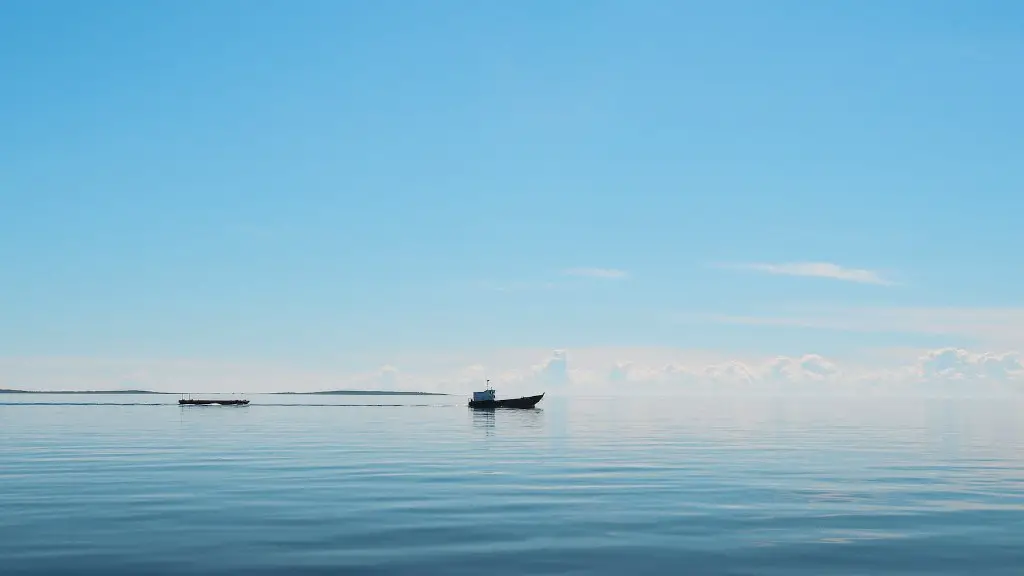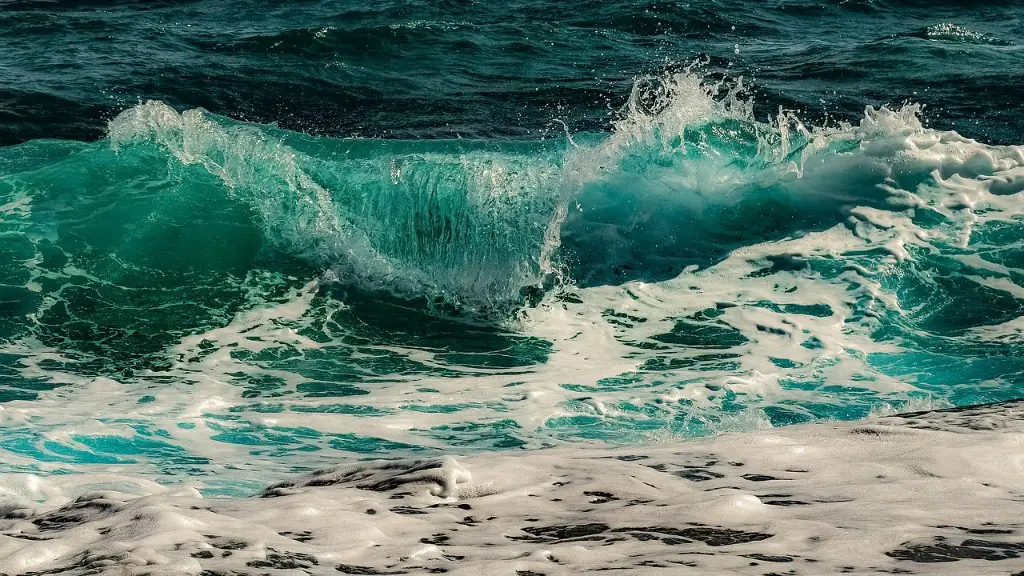History of Militarization in the South China Sea
The South China Sea is an area of considerable strategic importance, with an estimated 11 billion barrels of oil and 190 trillion cubic feet of natural gas in its waters. In recent years, much attention has been focused on territorial disputes involving several countries in the region. The Philippines, in particular, is embroiled in a long-running dispute over its exclusive economic zone with China, which has been accused of militarizing the sea.
The conflict began in 2012, when a Chinese naval vessel fired warning shots at a Philippine fishing boat near the Scarborough Shoal, located west of the Philippines and claimed by both countries. This triggered a series of confrontations and standoffs which continue to this day, with China allegedly building artificial islands in the South China Sea and claiming large swathes of waters and land as its own. China has also deployed an array of naval ships, fighter jets, and military personnel to the area.
The Philippines, on the other hand, has largely been on the defensive, deploying only limited military assets of its own. In June of 2019, however, the Philippine government announced that it had approved a plan to purchase several warships from South Korea, primarily for use in the South China Sea. This marked a significant escalation in the country’s military presence in the area and reignited concerns about a greater militarization of the South China Sea.
International Perspective
The militarization of the South China Sea has attracted significant attention from the international community, both in terms of rhetoric and action. On several occasions, the US and other countries have accused China of violating international law and intimidating its smaller neighbors in the region. The US also initiated freedom of navigation operations (FONOPS) in the South China Sea in 2015, sailing navy ships in close proximity to China’s artificial islands and challenging Beijing’s claims to the area.
The US and other nations have been deeply critical of China’s buildup, accusing Beijing of provocative and aggressive behavior. However, there is much debate about whether or not China is actually engaged in a process of militarization or simply defending its interests in the region. China has consistently maintained that it is merely protecting its sovereignty and that its military exercises in the South China Sea are lawful and not provocative.
Meanwhile, the Philippines has been mostly reluctant to get involved in the confrontation, instead opting for treaties and diplomatic agreements. However, Manila has recently taken a more assertive stance by sending warships to the South China Sea, raising concerns that the country could be sliding further towards militarization.
Domestic Perspective
Within the Philippines, opinions on militarization are largely divided. Many Filipinos are concerned by the escalating tensions in the South China Sea and the potential ramifications for the country. They cite the economy as one of the main reasons for opposing militarization, arguing that the cost of military exercises and weapon purchases could be better spent elsewhere.
On the other hand, there are also those who support a more assertive approach towards China. They point to the fact that the Philippines has a much smaller and less advanced military than China and argue that the country needs to bolster its defense capabilities if it wants to successfully protect its interests in the region.
Interestingly, despite the differences in opinion, most Filipinos agree that diplomatic solutions should be the primary focus of the government. This is reflected in public opinion polls in which nearly 60% of respondents stated that negotiations, rather than military action, were the best way to resolve the dispute over the South China Sea.
Economic Impact
For the Philippines, a major concern is the economic impact of militarization. The sea is an important source of trade, resources, and foreign investment, and any escalation of tensions could have serious repercussions. With China having the upper hand militarily, there is a risk that Beijing could impose economic sanctions or block Philippine vessels in the South China Sea, disrupt trade lanes, or restrict access to resources.
In addition, the cost of militarization could be substantial. The acquisition of warships and other military equipment, as well as the maintenance and deployment of troops, would require significant financial resources. There is also the possibility of human casualties in the event of an armed conflict, which would have disastrous consequences and could strain the country’s already fragile economy.
Agreements and Treaties
As a way of defusing tensions, several countries in the region have signed various agreements and treaties. The ASEAN Regional Forum, in particular, has helped to bridge the divide between claimants and has enabled negotiations to take place under a multilateral framework.
The Philippines has also used this platform to reiterate its position on the South China Sea dispute, reaffirming its commitment to a peaceful resolution. It has repeatedly emphasized the need for mutual respect and dialogue, while also calling on China to respect international law and the rule of law.
The Philippine government has also vowed to pursue diplomatic solutions, and President Rodrigo Duterte has made it clear that he intends to resolve the dispute through negotiations, not through military action. In recent months, the two countries have engaged in backchannel talks, reportedly focusing on a possible joint development agreement.
Legal Framework
The final piece of the puzzle is the legal framework which governs claims to the South China Sea. To date, no definitive ruling on the dispute has been made, leaving the fate of the area in limbo. The Philippines has consistently argued that China’s extensive claims are in violation of UNCLOS, or the United Nations Convention on the Law of the Sea, which upholds its exclusive economic zone.
China has dismissed this argument and maintains that its claims are based on historical rights, citing evidence dating back to the Han dynasty. It has also argued that UNCLOS does not fully address its position, citing the fact that it is not a signatory to the document.
In July 2016, the Philippines took the dispute to The Hague, filing an unprecedented suit challenging China’s claims to the South China Sea. The outcome of the case is still pending, and many are hopeful that an outcome favorable to the Philippines will be reached.
Regional Dynamics
The South China Sea dispute is increasingly seen as a regional issue, with several countries playing a role in finding an effective resolution. In addition to the Philippines and China, Japan and other countries have also been drawn into the dispute, offering a range of solutions. Most recently, Japan offered to mediate the dispute and is reportedly working on a framework that would involve all claimants in the South China Sea.
At the same time, many ASEAN countries have sought to downplay the dispute and maintain close ties with China. The organization has consistently called for a “peaceful resolution” to the situation, stressing the need for cooperation and dialogue.
Overall, the South China Sea dispute is an extremely complex issue, with a multitude of competing interests and dynamics. A lasting solution will require a delicate balance of diplomacy and compromise, with all parties working together in the spirit of mutual respect and understanding.
Implications for Security
The militarization of the South China Sea is a source of major concern for the region, and its implications for regional security should not be underestimated. An escalation of the dispute could lead to a breakdown in regional cooperation and an increase in geopolitical tensions, with far-reaching implications.
Some experts are also concerned about the possibility of a naval conflict, pointing to the presence of rival military forces in the area. Such a conflict would have catastrophic consequences for the region, with significant economic and human costs.
For the Philippines, the implications of militarization are even more pronounced, given its vulnerability to China’s growing military power and the potential damage to its security, economy, and international standing. In the end, the Philippines must be prudent and take a considered approach in addressing the issue, while doing its utmost to protect its interests in the South China Sea.
Environmental Impact
The South China Sea is home to some of the world’s most important marine ecosystems, and any escalations of tensions could have serious consequences for the environment. Military activities, in particular, have been known to have detrimental effects on significant species and habitats, and some experts fear that further militarization could have a negative impact on the area.
The environmental damage could be compounded by natural disasters such as typhoons and rising sea levels, both of which are projected to worsen in the coming years, thanks to climate change. The South China Sea is already the site of significant coral reef bleaching, and further militarization could only exacerbate the situation.
Ultimately, the South China Sea is a rich and diverse marine environment which must be protected. The ecological balance should be restored, and military practices should be conducted in a responsible manner to avoid further damage.
Public Opinion
The militarization of the South China Sea is of great public interest in the Philippines, with opinion polls showing that the nation is deeply divided on the issue. On one hand, many Filipinos are in favor of an assertive approach towards China and are supportive of the country’s militarization efforts. On the other hand, others are concerned by the potential economic and human costs of such actions and would prefer a more diplomatic solution.
At the same time, most Filipinos agree that theSouth China Sea dispute must be resolved peacefully, through negotiations and international agreements. It is clear that a lasting solution will require compromise and understanding from all sides, and a commitment to preserving the area’s ecological balance and regional security.
Conclusion
The Philippines’ move towards militarization in the South China Sea has attracted significant attention from the international community. While many are concerned by the escalating tensions, the debate over military action versus diplomatic solutions is still ongoing. Ultimately, the only way to resolve the issue is through negotiations and compromise, and the hope is that all parties involved can find common ground and a way forward.





